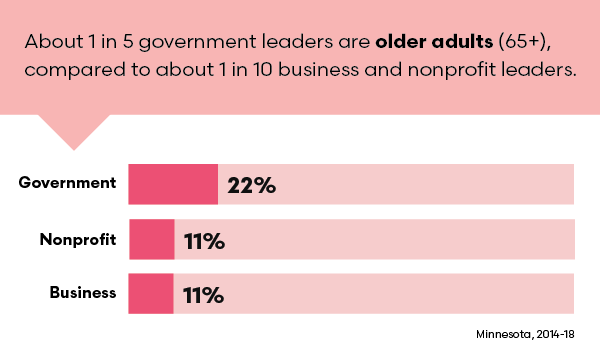Do Minnesota’s leaders reflect the diversity of the populations they employ and serve?
It’s important to know.
Leaders shape our institutions. They define organizational culture and make decisions that have long-standing and wide-ranging impact on people and communities. It matters that these leaders reflect and respond to the diversity of those they employ and serve.
Understanding the diversity of leaders can help us respond to future workforce needs, nurture efforts to increase equity and inclusion in our businesses and institutions, and strengthen social, economic, and cultural ties that make Minnesota unique.
So do our leaders reflect Minnesota’s diversity? Minnesota Compass and the Bush Foundation have teamed up to answer this question.
What do we mean by “leadership”?
For this work, we defined leadership exclusively as those at the highest level of management within their institutions, with authority and responsibility for the strategic and operational direction of their organizations.
This project aims to pull together information from a variety of sources. So far, we have collected and analyzed existing data from the U.S. Census Bureau on the characteristics of leaders in government, business, and nonprofit institutions across Minnesota. Using responses to the American Community Survey, we compiled estimates of the number of top executives and elected officials in Minnesota by gender, race, age, education, income, disability, and veteran status. We also compiled the same characteristics of Minnesota’s entire adult population age 25 or older to compare the diversity of leaders with the diversity of anyone in our state eligible to step into similarly prominent leadership roles.
Who leads in Minnesota?
Here’s what we have learned so far:
- The majority of leaders in Minnesota are middle-aged. One in three CEOs or elected officials in Minnesota are between the ages of 45 and 54. But government leaders are disproportionately older compared with leadership in businesses or nonprofits. The share of government leaders age 65 or older is double the proportion of leaders in that same age group leading for-profit or nonprofit organizations.

Young adults are not only underrepresented in leadership roles, the share of young adults in leadership is also declining. Today, about one in four leaders in Minnesota is a Millennial, compared to one in three leaders just a few years ago.

With much of the Baby Boomer generation in the midst of retirement, young adults need to be encouraged into leadership pathways and promoted into leadership positions to ensure smooth transitions of authority and institutions.
- People of color are underrepresented among leaders across all three sectors. While 15% of Minnesota’s adults are people of color, only about 5% of leaders across Minnesota are people of color.

We would need to see at least three times as many people of color in positions of leadership in order to reach parity with the population of color among Minnesota's adults.
- Women are also underrepresented among leaders across all three sectors. Across business and government sectors, a greater share of leaders identify as men compared to the people they employ and serve. While 50% of Minnesota’s adults are women, only 24% of leaders across Minnesota are women. Leadership in the for-profit sector, in particular, lags in representation of women, with only 22% of top-level management positions like CEO, president, and executive director held by women. However, in a demographic survey conducted by Wilder Research, nearly two-thirds of leaders in the nonprofit sector who participated in the survey identified themselves as women.

The demographic and economic characteristics of leaders in Minnesota give us some insight on how responsive our institutions are to changing populations.
As Minnesota grows older and more racially and ethnically diverse, what changes in leadership should we expect and how can those changes impact decisions, investments, and priorities? These are the questions we hope to address by providing reliable estimates of the demographics of Minnesota leaders for years to come.
This is just the start!
The highlights above only go so far in answering, “Who leads in Minnesota?” In addition to providing annual updates from existing data sources, our work on this project will also equip you with information and resources about Minnesota’s leaders, their pathways to leadership, and leadership development.
- With support from the Bush Foundation – and in partnership with the Minnesota Council of Nonprofits, the League of Minnesota Cities, and the Minnesota Chamber of Commerce – we have collected data from leaders in the nonprofit, government, and business sectors to better understand who leads and how our institutions are developing talent. Dive into the data here.
- Our "spark change" section provides inspiration by telling the stories of communities and organizations that are championing diverse and inclusive leadership.
- "Spark change" also links to our racial equity resource directory and our brand-new leadership development program directory. This resource details leadership development programs available across the state and nationally for Minnesota leaders at all career stages. Search for the program that best fits your needs, or suggest a program to be added.
Sign up for our newsletter to be one of the first to receive the latest leadership data.
